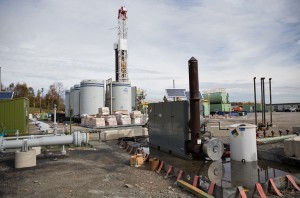Study finds methane emissions are higher than government estimates
Federal estimates significantly undercount the amount of methane emitted in the U.S. from leaking natural gas systems and other sources, according to a new study in the journal Science.
Researchers reviewed more than 200 studies of methane emissions in the U.S. and Canada published over 20 years and concluded that emissions are probably about 50 percent higher than the Environmental Protection Agency’s official tally suggests.
Methane is more potent but shorter-lived than carbon dioxide, which is the primary greenhouse gas emitted through human activities.
The authors, from universities, national laboratories, government agencies, and other organizations, found that even with the higher-than-estimated leak rates of methane, natural gas is better for the climate over 100 years than coal when burned to create electricity but likely worse for the climate than diesel when used to power trucks and buses.
“Fueling trucks and buses with natural gas may help local air quality and reduce oil imports, but it is not likely to reduce greenhouse gas emissions,” said lead author Adam Brandt, an assistant professor of energy resources engineering at Stanford University. “Even running passenger cars on natural gas instead of gasoline is probably on the borderline in terms of climate.”
Pennsylvania promotes the use of natural gas as a transportation fuel and established a three-year, $20 million grant program through Act 13 to encourage more natural gas vehicle use.
“While lowering emissions is a key objective of natural gas usage (and other alternative energy fuels), we need to be mindful that there are other key reasons to support utilization,” Gov. Tom Corbett’s energy executive Patrick Henderson said in an email. “Doing so helps diversify our transportation fuel portfolio, which is overly dependent on oil. It increases our national security by reducing imports from unstable regions of the world. It can save consumers money through lower-cost fuel; and it keeps those dollars right here circulating in our economy.”
The researchers did not determine where the excess methane is coming from, but named potential reasons for the undercount, including that the EPA’s emissions assumptions are based on outdated technologies, voluntary sampling, and an accounting that does not include methane sources like wetlands and abandoned gas wells.
The study noted that hydraulic fracturing for natural gas is “unlikely to be a dominant contributor to total emissions,” while a small number of so-called “super-emitters” — very large leaks at well sites, gas processing plants and tanks — could be responsible for a significant amount of the leakage from natural gas systems. One study the researchers cited measured about 75,000 components at processing plants and found that 58 percent of emissions came from about 50 leaky parts. That means finding and fixing the worst leaks could have big benefits, they wrote.
The industry has a natural incentive to stop methane leaks: lost gas equals lost money. Regulations are also guiding the industry toward reducing some emissions. New and upcoming state and federal rules designed to curb smog-forming air pollution from natural gas wells and infrastructure will require companies to use technologies that also capture methane.
Natural gas is not a long-term climate solution because far greater cuts in greenhouse gas emissions are necessary, co-author Francis O’Sullivan of the MIT Energy Initiative, told National Geographic. “But it can have significant benefits in the near term,” he said.
Methane is a more potent greenhouse gas than climate scientists previously thought, according to an Intergovernmental Panel on Climate Change report released last fall: methane is 34 times more effective at trapping heat than carbon dioxide over a 100-year period and 86 times more effective over a 20-year period.
“We only have about 20 to 30 years before we reach the warning zone of temperature rise that could lead to climate tipping points,” said Cornell University engineering professor Anthony R. Ingraffea, who disagreed with the authors’ optimism about the potential for quickly fixing leaks and their use of a 100-year period to evaluate the climate benefits of natural gas.
“Given the brief 20-year period we have left to decrease [carbon dioxide equivalent] emissions, such fixes will not be in time,” he said.
The study was funded by the nonprofit organization Novim through a grant from the Cynthia and George Mitchell Foundation, which is named for the late pioneer of hydraulic fracturing.
This post has been updated to include comments from the governor’s energy executive.

















